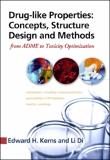Drug-like properties: concepts, structure design and methods from ADME to toxicity optimization
| dc.contributor.author | Kerns, Edward H. | |
| dc.contributor.author | Di, Li | |
| dc.date.accessioned | 2020-08-11T09:48:52Z | |
| dc.date.available | 2020-08-11T09:48:52Z | |
| dc.date.issued | 2008 | |
| dc.identifier.citation | Kerns, Edward H. and Di, Li (2008). Drug-like properties: concepts, structure design and methods from ADME to toxicity optimization. New York : Elsevier. | en_US |
| dc.identifier.isbn | 978-0-1236-9520-8 | |
| dc.identifier.uri | http://hdl.handle.net/123456789/1363 | |
| dc.description.abstract | Drug research is a fulfilling career because new drugs can improve human health, quality of life, and life span. For scientists dedicated to drug research, it can also be a supremely challenging mission, owing to the numerous attributes that must be simultaneously optimized to arrive at an efficacious drug-like compound. ADME/Tox (absorption, distribution, metabolism, elimination, toxicity) is one of these challenges. Of the thousands of novel compounds that a drug discovery project team invents and that bind to the therapeutic target, typically only a fraction of these have sufficient ADME/Tox properties to become a drug product. This book is devoted to providing you, the drug research scientist or student, with an introduction to ADME/Tox property concepts, structure design, and methodology to help you succeed with these challenges. | en_US |
| dc.language.iso | en | en_US |
| dc.publisher | Elsevier | en_US |
| dc.subject | Pharmaceutical chemistry | en_US |
| dc.subject | Drugs—structure-activity relationships | en_US |
| dc.subject | Drug development | en_US |
| dc.subject | Drugs—design | en_US |
| dc.title | Drug-like properties: concepts, structure design and methods from ADME to toxicity optimization | en_US |
| dc.type | Book | en_US |
الملفات في هذه المادة
هذه المادة تظهر في الحاويات التالية
-
Pharmacy [209]







